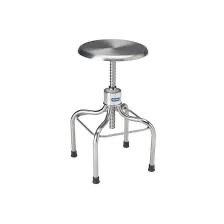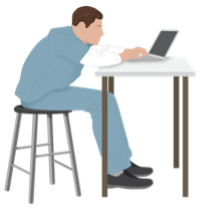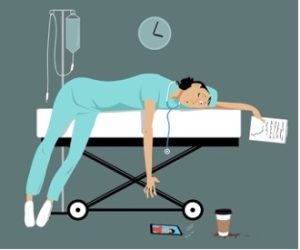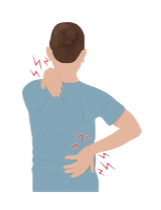Up early, long days, rushed eating, too few bathroom breaks, and nagging neck and back pain. Have you been giving anesthesia for so long that you can’t imagine feeling any other way? In this month’s article, let’s talk about the nurse anesthetist work environment, physical repercussions of working in the OR, its consequences, and what you can do to keep yourself safe.
|Table of Contents:
- The Physical Demands of our Daily Work
- Drinking, Eating, and Bathroom Breaks
- Fatigue
- The Job of Anesthesiology Has Not Become More Body-Friendly
- Your Action Plan
The physical demands of our daily work and nursing injuries
Many of us routinely experience aches and pains at the end of a shift or workweek. But, when you prepare your room for the long vascular case or the never-ending breast reconstruction procedure and see your little companion, the OR stool, does it become your body’s friend or foe? The physical demands of nurse anesthetists can easily lead to injury, if we’re not careful.
Will you be straining your back, shoulders, and neck to check the low-hung Foley bag or down on your knees to check your patient’s pressure points? How about dragging around the anesthesia machine to make room for the portable x-ray?

Then, there are days you long for your uncomfortable stool! Maybe it’s a day packed with bilateral myringotomy tubes in kids or a long shift in the endoscopy suite with a lightning-fast proceduralist. Relentlessly standing, twisting, and bending may leave you feeling like you’ve done hours of Pilates, but with swollen, aching feet, to boot. Varicosities anyone?
And how about accessing the computer with the EMR? Does it encourage optimal (safe?) body mechanics, or must you contort your body by stretching your arms, back, or neck to access the keyboard? Carpal tunnel, anyone? The setting is ripe for all kinds of stress injuries.

When you intubate, do you ever misalign your neck, shoulders, and back to get the best view? And what about moving the patient after anesthetizing them? Ever feel a twinge or a strain?
Workplace-related neurologic and musculoskeletal disorders loom in all nursing specialties (RNs, NPs, and CRNAs) and remain poorly studied in anesthesiology. These nursing injuries are prevalent and are associated with the physical demands of delivering one-to-one patient care. In isolation, each occurrence might not seem like much, but repetitive, daily stressors in the aggregate can exact a toll on the body, leading to stress injuries.
Drinking, eating, and bathroom breaks
Why does the lack of breaks create stress? Some of us have work environments where we can depend on regular breaks, meeting our basic needs, yet others have to fend for themselves. Different scenarios threaten relief. For example, you may be a specialist (pediatric, cardiac, transplant) who requires specialist relief, a staffing shortage may arise, or a break is offered at an inopportune time (induction, emergence). Many times these offers do not come back.
Bathroom visits are an inevitable part of life. However, a disconnect may exist between the need for a break and the offer of one. Our milieu doesn’t allow for the convenience of the porta-potty of the construction site, though we may wish for one (we’ve all heard stories of people getting creative in the OR).

Fatigue
We marshal our knowledge, experience, and skill to the patient, maintaining unwavering vigilance. However, fatigue erodes cognitive and motor function. Add a lingering illness, stress, or poor sleep to the mix, and we set the stage for a flawed response to a clinical challenge. The National Institute for Occupational Safety and Health reports that being awake for 17 hours equals a blood alcohol content (BAC) of 0.05%. Being awake for 24 hours is similar to a BAC of 0.10%. You may recall a BAC of 0.08 is driving a car intoxicated (i.e., a DUI).
The AANA, ASA, and the Anesthesia Patient Safety Foundation all note fatigue’s role in the genesis of industrial, aviation, military, and healthcare error. The anesthesia literature, including Closed Claims Analysis, is flush with cases where an adverse event was attributed to a fatigued provider.
The job of anesthesiology has not become more body-friendly
Despite drug and technology advances, the mental and physical demands on nurse anesthetists providers remain relatively unaddressed. Many of us are aware of the toll exacted on the body. We’ve heard from colleagues about muscle spasms, numb fingers, chronic headaches, dehydration, and feeling somatically worn out by the job demands.

Occupational injuries in healthcare delivery represent an enormous socioeconomic burden with an estimated impact exceeding $190 billion annually, ranking third among all U.S. industries. Many acute or chronic injuries go unreported. Yet, at the start of our careers, how many of us anticipated nurse anesthesiology as carrying significant physical demands? If you’re still in training or early in your career, the physicality of our specialty may not appear evident. Like water over a rock, the demands of your labor will shape you over time.
Your action plan
We recall advice from Susan Del Gatto, “if you elect not to manage an issue, then you relinquish your right of control over the issue, and it will select the path of least resistance.”
- Be mindful of your ergonomics throughout the day. You must advocate for yourself because you can safely assume no one else in the OR will do it for you. For example, you determine the ideal table height and patient position during induction and emergence — not the OR staff who grumble about having to move the patient afterward.
- Take a moment to think about the cases and tasks that stress your body. What can you do to protect yourself?
- Meet as a department and discuss the most efficient manner to provide substantive relief breaks.
- Remember to drink water, eat well, get appropriate rest, and consider the value of stretching in your routine.
- Request an appropriately designed, ergonomic OR chair.
Burnout and stress injuries put your earning potential and overall job satisfaction at risk. Listen to your body. After all, it’s the only one you’ve got.
As CRNAs ourselves, we understand the challenge of fitting CRNA continuing education credits into your busy schedule. When you’re ready, we’re here to help.







